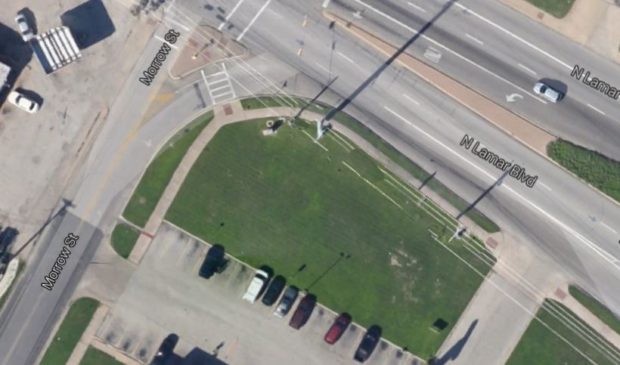‘Pork chop’ included in updated list of quarter-cent fund projects
Friday, April 24, 2020 by
Ryan Thornton District 4’s “pork chop,” a controversial traffic island at the intersection of Morrow Street and North Lamar Boulevard, is finally slated for removal after City Council adopted an updated list of projects approved for Capital Metropolitan Transportation Authority’s quarter-cent fund on Thursday.
The estimated $475,000 improvement will be funded by a sizable chunk of District 4’s remaining quarter-cent dollars, most of which has been spent since Council adopted the initial list of transportation projects in January 2016. The transportation money dates back to 2001, when Capital Metro agreed to pay the city a quarter of its share of sales tax between 2001 and 2004 in exchange for various transportation infrastructure projects.
“It really is a project that, while in one corner of the city, does reflect … a citywide priority of getting to a place where our transportation infrastructure is well-connected and serves all people,” said District 4 Council Member Greg Casar.
In April of last year, Casar brought Council an amendment to the Austin Strategic Mobility Plan’s Street Network Table and Map outlining the “expand roadway” project. As described in the quarter-cent project list, the total project may include removal of the pork chop, converting the westbound “slip lane” on Morrow Street into a “smart right-turn lane,” signal and crosswalk improvements, and new sidewalks west of the intersection on the north side of Morrow between Lamar and Easy Wind Drive.
Robert Spillar, director of Austin Transportation, previously recommended the sidewalk construction as a necessary measure before opening up westbound connectivity, a suggestion based on traffic modeling that showed the improvements more than doubling the number of daily vehicle trips on Morrow west of Lamar.
Nick Pellicciotto, a resident of the Highland Heights neighborhood east of Lamar, said the traffic island blocks westbound traffic from crossing or turning south onto Lamar and makes for a “really sketchy” intersection. “This has been a big issue for Highland residents since it was installed and was one of the foundational items for the creation of the Highland Neighborhood Association,” he said.
Other items on the updated quarter-cent list include Safe Routes to School improvements, new sidewalks, traffic-calming infrastructure, bicycle and pedestrian paths, and pedestrian hybrid beacons, which several Council members said have already made their districts safer since several were installed across the city with quarter-cent fund dollars.
“I never thought in a million years having a pedestrian hybrid beacon go up in your district would give you actual joy, but it’s been great to see that safety being added throughout our city,” said Mayor Pro Tem Delia Garza. “I know splitting up the quarter-cent fund was slightly controversial in the beginning, but it’s been really great to see these projects throughout our districts.”
Council Member Kathie Tovo, whose district has previously spent its $1.9 million allocation – largely on sidewalks and pedestrian hybrid beacons – said one particular pedestrian signal at West Oltorf Street and Durwood Street in South Austin has made a big difference for families and children walking to the nearby grocery store and other destinations.
For her district’s only new project, Council Member Leslie Pool praised the $330,000 of sidewalk improvements on the east side of Bull Creek Road north of West 45th Street. With its proximity to Highland Park Elementary School west of MoPac Expressway, Pool said the project is essentially a Safe Routes to School measure that will “tremendously” improve safety for children walking to school.
Mayor Steve Adler, who initially voted against the process of dividing the remaining quarter-cent dollars equally between districts, said the program has enabled communities to come together over their own common goals, open up conversations with their representatives, and get projects done. Adler said his previous worry that the process could lead to ward politics has proven to be unjustified.
The Austin Monitor’s work is made possible by donations from the community. Though our reporting covers donors from time to time, we are careful to keep business and editorial efforts separate while maintaining transparency. A complete list of donors is available here, and our code of ethics is explained here.
You're a community leader
And we’re honored you look to us for serious, in-depth news. You know a strong community needs local and dedicated watchdog reporting. We’re here for you and that won’t change. Now will you take the powerful next step and support our nonprofit news organization?






